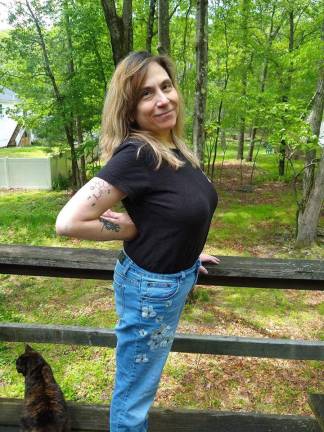As roots grow out, it’s a chance for a new look
Hair. “I spent a lot of time during the shutdown looking at pictures of beautiful women with gray hair to psych myself up.”


Kathleen Kelly-Volpe started coloring her hair when she was about 35. “I was getting divorced,” she said, laughing. “I decided I wanted to play with my hair for the first time. I didn’t even have gray hair, really, I just did it.”
At 62, a grandmother of six, she’s decided that now is the moment to let the silver emerge. It’s not because salons were closed – Kelly-Volpe has always dyed her own hair (and often cut it herself, too). She has one last box of L’Oreal French Roast under her bathroom sink. But everyone was in the same boat now, their roots growing out in quarantine. What better time?
“It was fun while it lasted, and it lasted all those years,” said Kelly-Volpe, an appointment coordinator for Hackensack Radiology Group who lived in West Milford, N.J., for eight years before moving back to Virginia. “But I really think at this point in my life it’s a healthier decision – whether you do it professionally, or whether you do it by yourself. I’ve done it by myself, and sometimes it would come down over my face – depending on where I was coloring, the sink or the tub,” she laughed. “One of my sister’s friends, for her health, had to stop coloring her hair.”
Her seven-year-old granddaughter asked her what she did to her hair. She noticed it in the way her grandkids notice when she’s not wearing her glasses. Her son told her she’s looking like Rogue, the heroine from Wolverine who has a white streak framing her face.
“The gray is now obvious,” she said. At her last haircut, her hairstylist told her that “underneath, I have a nice salt-and-pepper thing going on.”
Dracula’s daughter
Pamela Chergotis is making the leap, too. Chergotis, a newspaper editor (full disclosure: she’ll be editing this story), started dying her hair at around 40. “I wasn’t ready to be gray yet,” said. “I thought of myself as being just too young. I grew up in a very ageist time, a very sexist time, where to be an old woman was to be pretty much worthless,. It was more than just vanity – it was trying to keep up on the job market, trying to keep yourself looking like somebody that someone might want to hire someday.”
She thought she might dye her hair for a decade, but after 10 years had come and gone, “I realized, oh my gosh, how am I going to get off this? And there really is no good way to do it except do it. It takes about one to two years before it’s all over with.”
The pandemic, when everyone had terrible hair for one reason or another, was her off-ramp. “So I spent a lot of time during the shutdown looking at pictures of beautiful women with gray hair to psych myself up, and there are many, many of them,” she said.
There are roles models aplenty in the world of entertainment, like Jamie Lee Curtis and Nicole Kidman, Helen Mirren, and Meryl Streep, even fashion mavericks who’ve gone so far as to strip their natural pigment to dye their hair gray, like Lady Gaga and Kylie Jenner. But there’s one arena where there’s not a white wisp to be found atop a woman’s head: the halls of power.
“When you look at women of my mother’s generation, and women of my own generation as well, you look at Nancy Pelosi – she’s in her 80s, right, and her hair, there’s not one gray strand,” said Chergotis. Susan Collins, the 67-year-old senator from Maine, “black black black.” Senator Dianne Feinstein of California has got to be “the worst offender” at 87.
“These are three of the most powerful women in the country, and even during the pandemic, there’s no roots, there’s no gray, no nothing. You would think that when a woman got to be that powerful, when they had bucked all of the sexism they grew up with, as I did, that they wouldn’t need to constantly be so vigilant about their gray. That they would just say, screw it, this is how I am,” said Chergotis. “Even Gloria Steinem, I don’t think her hair is gray.”
Sally Sussman, vice president of Pfizer, embraced her gray since the pandemic. “I don’t know who wrote the rules of women’s hair, but I’ve obeyed them,” she wrote in an essay for Time magazine. “For women in big corporations – and I’ve worked in three, American Express, Estee Lauder, and Pfizer – there are two rarely broken codes: every woman has a silky straight blowout, and hardly anyone is gray.”
Chergotis found herself channeling her Uncle Nick, who had a hair salon in Bayonne, N.J., where she’d hang out as a kid. “I remember him saying it’s too bad so many women feel like they have to change the color of their hair. Especially as they get older, they cling to the hair color they were born with,” when in fact lighter tones are much kinder to aging skin. “When a woman’s hair goes gray, it has a softening effect. It goes beautifully with her skin. It’s like one of mother nature’s blessings. He was so funny, he said, ‘You don’t want to look like Dracula’s daughter, with black hair next to a face full of wrinkles.’” She laughed. “I always remembered that: before I get to the Dracula’s daughter stage, I’m definitely going to give it up.”
Chergotis calls her transitional hair the “Dutch rabbit look.” She once had a Dutch rabbit as a pet: they’re half black, half white, with a sharp line of demarcation. She’s looking forward to seeing what her hair looks like at the other end: will it be snowy white, or salt and pepper?Chergotis hopes that – much like mask-wearing – gray hair will start to seem unremarkable as more women let nature do its thing. “It won’t look so weird,” she said. “I won’t be picked out as the old lady at work. The more of us that do that, the more accepting of a climate there will be.”
Next time, go big
Getting off the coloring treadmill can translate to major savings. Coloring your hair every six weeks at the nationwide average of $100 per session, you’ll drop $860 a year – reports Lorraine Massey, in “Silver Hair: A Handbook” (2018). If you dye your hair from age 25 to 65, you’re looking at $34,400 over the course of your lifetime. At two to three hours per session, you’ll spend about a day a year in the salon chair. Do that for 40 years, and you will have spent more than a month of your life in a salon, not including travel time.
For many, though, going to the salon is less a chore than an affordable luxury, a rare moment to put your feet up and get caught up on celebrity gossip. “It’s nice to get out of the house for two to three hours on my own and be pampered, and then, at the end of it, voila,” said Christine Cangro, 52, of Milford, Pa., who is permanently disabled as well as immune-compromised. “Sometimes you do have to spend a little bit on yourself to make yourself for good.”
Cangro has been dying her hair for about 20 years, when she decided to go from brunette to bleached blonde. She’s had a mohawk, pinstriped bangs, “everything, just to shake it up a little bit in my boring life,” she said. “I think it kind of gives me a little bit of an identity, almost like doing something bad, when you really don’t. Besides the funky colors and the peacocks and all of that, it just gives me a good feeling, like I can almost be somebody else by the changing of my hair color. Because people do look different – when you’ve been really dark brown your whole life and all of a sudden you’re a bleached blonde, it’s a big change.”
Cangro’s last hair appointment was in October, right before the Comic Con. She hasn’t left the house since early March. It’s been a transformational time: she’s lost 30 pounds in quarantine, per her cardiologist’s recommendation. The color coming in now is brunette again. “I don’t think I have that gene,” she said of gray hair. Seven inches above the brown, it’s strawberry blonde, blue, green, a little purple – like an archaeological dig of fun times. “I really like the color that it’s grown into, with all the highlights from all the different colors that have come in, and all the bleaching I had to do. Even if it’s not like a stark bleached color, I like the way it is now, there are different streaks in it with different colors, all light and dark.”
She would like to keep the fun colors coming, but “grooming is last on my list of things to do while trying to keep healthy and safe,” she said. “My main concern is having to get out and see the doctors in person that I need to see, because I do have health issues. So getting my haircut, even just getting my bangs cut, is like way low on the list.”
If and when the time comes to venture back out to the salon, she’s going big. “I want to do maybe a strawberry blonde with a little copper in there. I need my bangs cut, and I want to do the pinstriping again, with just all the different colors, whatever they have: the turquoise and the orange and the green and the blue and the fuchsia, just alternating stripes, all up and down the bangs.”
’All into easy’
Diane Schmidt Triglianos, 52, of Milford, Pa., had already made up her mind to give up dying her hair, but the pandemic “kind of made me feel like I wasn’t the only one,” she said. She had begun lightening her hair herself a year or two earlier, when she started noticing grays. But the dye had dried out her blonde hair, and it was beginning to thin. Gray hair, she decided, was better than no hair. She knows a lot of women who are headed back to the salon now, “but I’m not going to change my mind. It’s not happening.”
An instructional assistant with Delaware Valley School District, Triglianos counts herself blessed to have been paid through the pandemic, but has no idea what her fall will look like. “It’s just been anxiety producing, not knowing what the future holds,” she said. “I’m afraid to go out. The last thing she needs is one more thing to worry about.
“I’m all into easy, especially now. I always wear my hair back in a ponytail now because I wear glasses on and off and I wear hearing aids, and then the stupid mask, so the hair just gets in the way.”
“I wouldn’t say I’m liking it,” she said, of the gray that’s coming in. “I would say, yes, I’m getting used to it. I always thought my pretty blonde hair was one of my better features. I don’t consider myself beautiful. But I’m also losing my hair, and I thought that was possibly due to the boxed hair dye, so whatever I can do to keep it as healthy as possible, I’m going to do.”
Triglianos was planning to visit her mom the next day for the first time since Christmas. At 82, she still colors her own hair. “So I’m curious to see if she says anything about mine.”